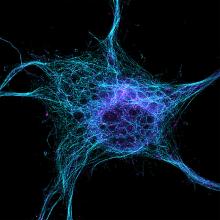
The NINDS Division of Intramural Research (DIR) is the internal research program of the NINDS and is among the largest neuroscience research centers in the world. It is home to more than 500 scientists who conduct leading-edge basic, translational, and clinical research in neuroscience, neurology, and neurosurgery research at NINDS laboratories in Bethesda, Maryland.
Basic research pursues an understanding of the normal and abnormal structure and activities of the human nervous system. Translational research applies the ideas, insights, and discoveries generated through basic science to potential new therapies for human disease. It bridges basic and clinical research —which applies directly to disease detection, prevention, and treatment.
NINDS Intramural scientists cover a broad range of neuroscience research, including molecular biophysics, synapses and circuits, neuronal development, integrative neuroscience, neurogenetics, neuroimmunology, surgical neurology, brain imaging, and neurological disorders.
The NIH DIR’s unique funding structure provides investigators with the stability, flexibility, synergistic environment, and resources to conduct distinctive long-term and high-risk, high-reward science that breaks new ground, defines scientific excellence, and improves human health.
Office of the Scientific Director
Office of the Clinical Director
Our Mission
DIR at a Glance
